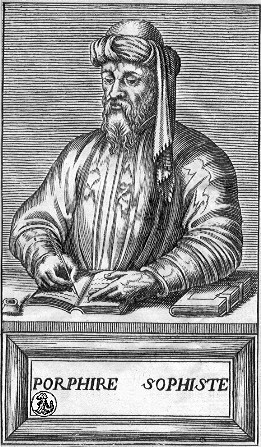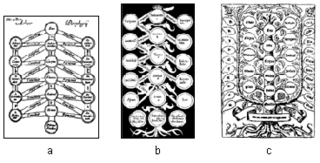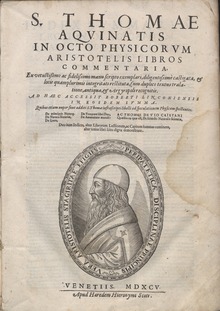Ammonius Hermiae was a Greek philosopher from Alexandria in the eastern Roman empire during Late Antiquity. A Neoplatonist, he was the son of the philosophers Hermias and Aedesia, the brother of Heliodorus of Alexandria and the grandson of Syrianus. Ammonius was a pupil of Proclus in Roman Athens, and taught at Alexandria for most of his life, having obtained a public chair in the 470s.
Simplicius of Cilicia was a disciple of Ammonius Hermiae and Damascius, and was one of the last of the Neoplatonists. He was among the pagan philosophers persecuted by Justinian in the early 6th century, and was forced for a time to seek refuge in the Persian court, before being allowed back into the empire. He wrote extensively on the works of Aristotle. Although his writings are all commentaries on Aristotle and other authors, rather than original compositions, his intelligent and prodigious learning makes him the last great philosopher of pagan antiquity. His works have preserved much information about earlier philosophers which would have otherwise been lost.

Aristotelianism is a philosophical tradition inspired by the work of Aristotle, usually characterized by deductive logic and an analytic inductive method in the study of natural philosophy and metaphysics. It covers the treatment of the social sciences under a system of natural law. It answers why-questions by a scheme of four causes, including purpose or teleology, and emphasizes virtue ethics. Aristotle and his school wrote tractates on physics, biology, metaphysics, logic, ethics, aesthetics, poetry, theatre, music, rhetoric, psychology, linguistics, economics, politics, and government. Any school of thought that takes one of Aristotle's distinctive positions as its starting point can be considered "Aristotelian" in the widest sense. This means that different Aristotelian theories may not have much in common as far as their actual content is concerned besides their shared reference to Aristotle.

The Organon is the standard collection of Aristotle's six works on logical analysis and dialectic. The name Organon was given by Aristotle's followers, the Peripatetics, who maintained against the Stoics that Logic was "an instrument" of Philosophy.

Porphyry of Tyre was a Neoplatonic philosopher born in Tyre, Roman Phoenicia during Roman rule. He edited and published the Enneads, the only collection of the work of Plotinus, his teacher.

The designation "Renaissance philosophy" is used by historians of philosophy to refer to the thought of the period running in Europe roughly between 1400 and 1600. It therefore overlaps both with late medieval philosophy, which in the fourteenth and fifteenth centuries was influenced by notable figures such as Albert the Great, Thomas Aquinas, William of Ockham, and Marsilius of Padua, and early modern philosophy, which conventionally starts with René Descartes and his publication of the Discourse on Method in 1637.
John Philoponus, also known as John the Grammarian or John of Alexandria, was a Coptic Miaphysite philologist, Aristotelian commentator and Christian theologian from Alexandria, Byzantine Egypt, who authored a number of philosophical treatises and theological works. John Philoponus broke from the Aristotelian–Neoplatonic tradition, questioning methodology and eventually leading to empiricism in the natural sciences. He was one of the first to propose a "theory of impetus" similar to the modern concept of inertia over Aristotelian dynamics. He is also the historical founder of what is now called the Kalam cosmological argument.
Olympiodorus the Younger was a Neoplatonist philosopher, astrologer and teacher who lived in the early years of the Byzantine Empire, after Justinian's Decree of 529 AD which closed Plato's Academy in Athens and other pagan schools. Olympiodorus was the last pagan to maintain the Platonist tradition in Alexandria ; after his death the School passed into the hands of Christian Aristotelians, and was eventually moved to Constantinople. He is not to be confused with Olympiodorus the Deacon, a contemporary Alexandrian writer of Bible commentaries.

In philosophy, the Porphyrian tree or Tree of Porphyry is a classic device for illustrating a "scale of being", attributed to the 3rd-century CE Greek neoplatonist philosopher and logician Porphyry, and revived through the translations of Boethius.
Boetius de Dacia, OP was a 13th-century Danish philosopher.
In the history of logic, the term logica nova refers to a subdivision of the logical tradition of Western Europe, as it existed around the middle of the twelfth century. The Logica vetus referred to works of Aristotle that had long been known and studied in the Latin West, whereas the Logica nova referred to forms of logic derived from Aristotle's works which had been unavailable until they were translated by James of Venice in the 12th century. Study of the Logica nova was part of the Renaissance of the 12th century.
Dexippus was an Ancient Greek Neoplatonist philosopher from the 4th century AD, whose wrote a commentary on the Categories of Aristotle which is partially extant.
Adrastus of Aphrodisias was a Peripatetic philosopher who lived in the first half of the 2nd century AD.

The transmission of the Greek Classics to Latin Western Europe during the Middle Ages was a key factor in the development of intellectual life in Western Europe. Interest in Greek texts and their availability was scarce in the Latin West during the Early Middle Ages, but as traffic to the East increased, so did Western scholarship.
Commentaries on Plato refers to the great mass of literature produced, especially in the ancient and medieval world, to explain and clarify the works of Plato. Many Platonist philosophers in the centuries following Plato sought to clarify and summarise his thoughts, but it was during the Roman era, that the Neoplatonists, in particular, wrote many commentaries on individual dialogues of Plato, many of which survive to the present day.
Michael of Ephesus or Michael Ephesius wrote important commentaries on Aristotle, including the first full commentary on the Sophistical Refutations, which established the regular study of that text.
Neoplatonism is a version of Platonic philosophy that emerged in the 3rd century AD against the background of Hellenistic philosophy and religion. The term does not encapsulate a set of ideas as much as a series of thinkers. Among the common ideas it maintains is monism, the doctrine that all of reality can be derived from a single principle, "the One".
Elias was a Greek scholar and a commentator on Aristotle and Porphyry.

Medieval philosophy is the philosophy that existed through the Middle Ages, the period roughly extending from the fall of the Western Roman Empire in the 5th century until after the Renaissance in the 13th and 14th centuries. Medieval philosophy, understood as a project of independent philosophical inquiry, began in Baghdad, in the middle of the 8th century, and in France and Germany, in the itinerant court of Charlemagne in Aachen, in the last quarter of the 8th century. It is defined partly by the process of rediscovering the ancient culture developed in Greece and Rome during the Classical period, and partly by the need to address theological problems and to integrate sacred doctrine with secular learning. This is one of the defining characteristics in this time period. Understanding God was the focal point of study of the philosophers at that time, Muslim and Christian alike.
The Summa Grammatica or Speculative Grammar was a work by the medieval Modist philosopher John of Dacia.







